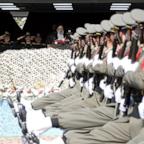Caustic Sludge Burns Through Hungarian Towns En Route to the Danube
Health fears linger as red sludge proves to be more caustic than 9/11 dust.
Oct. 8, 2010— -- The caustic, red sludge that burst from a reservoir at an aluminum plant Monday has been found to be 1,000 times more caustic than the dust at ground zero on 9/11, an environmental health expert has said, amid growing concerns about the lingering effects of the toxic spill.
The flood of sludge burned more than 120 people and killed five as it left a reddened swath of devastation in western Hungary this week, according to environmental advocates on the scene.
After decimating the fish population of the Marcal River, the toxic slurry became more diluted as it reached the mighty Danube River. The torrent of alkaline mud that swamped homes, cars, roads and bridges, particularly in the town of Kolontar, contained byproducts from aluminum manufacturing, which uses caustic soda to turn bauxite, or aluminum ore, into lightweight metal.
The environmental group Greenpeace said Wednesday that the pH level of a mud sample it took from one of the affected towns was 13 -- a level more caustic than household bleach. However, by late Thursday, pH levels closer to the Danube had dropped "down to 9 ... but there are still dead fish floating around," Martin Hojsík, toxics water campaign coordinator for Greenpeace International, wrote in an e-mail.
Greenpeace sent sludge samples from Kolontar to two outside labs, and planned to release results with pH testing and evidence of heavy metal contamination Friday, Hojsík said.
In the absence of good, early information about toxic metals, scientists were could only comment on the extreme alkalinity of the sludge.
"A pH of 13 is about as caustic as it gets. This stuff will dissolve anything it touches," said Dr. Philip J. Landrigan, chairman of preventive medicine and dean for global health at Mount Sinai School of Medicine in New York. Acidity and alkalinity are measured on a scale from 1 to 14, with 7 considered neutral. A pH of 1 indicates extreme acidity, like pure sulfuric acid, and a pH of 13 or 14 indicates extreme alkalinity, he explained. "Liquids of extreme alkalinity burn whatever they touch. Like lye."
By way of comparison, Landrigan said that the dust produced by the collapse of the burning World Trade Center towers on Sept. 11, 2001, "had a pH of 10 to 11 and wreaked havoc on workers' lungs." One of the first scientists to analyze the 9/11 dust, Paul J. Lioy, chairman of environmental medicine at the University of Medicine and Dentistry of New Jersey, found that the dust got its high pH level from tiny particles of naturally caustic cement.
Landrigan said that the pH scale is logarithmic, "so every unit increase on the scale means a 10-fold increase in alkalinity. So this stuff is 1,000 times more caustic than the 9/11 dust."




